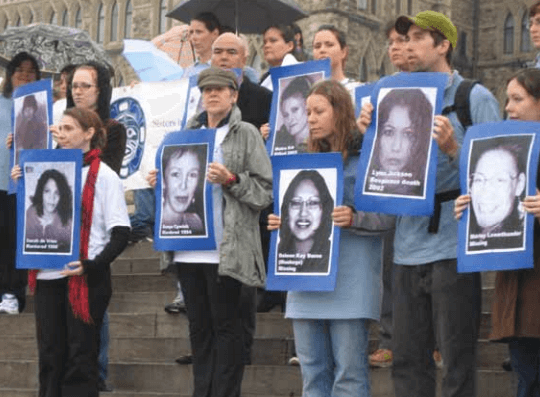Canada has failed its Indigenous women and girls
Even after years of resistance, more needs to be done for Manitoba’s murdered and missing Indigenous women and girls
Justine Ponomareff
This year, Canada celebrates its 150th birthday. Ours is a country of rich history—but not all Canadian stories are told equally. In this special report, This tackles 13 issues—one per province and territory—that have yet to be addressed and resolved by our country in a century and a half

In 2012, the Sisters In Spirit Vigil in Ottawa asked volunteers to silently hold pictures of missing and murdered Indigenous women and girls. Photo courtesy of the Native Women’s Association of Canada.
For decades, Indigenous women in Canada have been resisting oppression. Canada’s institutions and systems, steeped in colonialism, racism, and sexism, have deemed Indigenous women as less worthy of raising their children, of having access to proper housing, income, or education.
They’ve also deemed them less worthy of life.
Between 1980 and 2012, there were 1,181 police-reported cases of murder and long-term disappearances involving Indigenous women and girls, the RCMP revealed in a 2014 report. Patty Hajdu, then-minister for the status of women, has cited the research of the Native Women’s Association of Canada suggesting the number could actually be closer to 4,000.
These numbers reflect what the families of missing and murdered Indigenous women have been saying for decades: There are hundreds of Indigenous women and girls whose lives have been dismissed by the government, police, RCMP, and the media.
Manitoba in particular has had a longstanding issue with racism and violence. In 2014, the province had the highest documented number of homicides of Indigenous people and recorded the second-highest rate of hate crimes. A 2015 Maclean’s feature exploring the province’s race problem found only 13 percent of Manitobans had “very favourable” views of Indigenous citizens.
Canadian police and the RCMP also have a history of discrimination in their treatment of missing Indigenous women and girls cases. Poor report-taking, ineffective coordination of and between police, failure to investigate properly, and insensitivity are all common complaints from family members of missing Indigenous women and girls. Families are often made to wait up to 72 hours to even report someone missing—an arbitrary, unofficial period of time, rooted in the stereotype that Indigenous women are transient and unreliable.
When institutions fail to protect a population, it renders them vulnerable to the violence of people who know they won’t face consequences for their behaviour. This culture of immunity is what makes Indigenous women six times more likely to be murdered than non-Indigenous women in Canada.
Last year, the Canadian government launched a national inquiry, with a budget of $53 million, into missing and murdered Indigenous women and girls. The inquiry has been scrutinized for a lack of transparency and communication with Indigenous communities in its planning stages. It does not include the police’s role in the violence Indigenous women and girls face.
Indigenous women have had to fight for their autonomy—and their lives—for far longer than this country has been called Canada. And that’s nothing to celebrate.
CLARIFICATION (JULY 31, 2017): This story has been updated to clarify that the estimated number of murdered and missing Indigenous women and girls is cited from NWAC research and not directly from former minister Patty Hajdu.